Have you ever written a great blog post, but then couldn’t find it in WordPress? This happens to many people, and it can be very frustrating.
Since we run a WordPress blog, we know this problem all too well. Thankfully, we’ve learned some good ways to find drafts that seem to be missing.
In this guide, we’ll show you how to find your saved drafts in WordPress, from the easiest method to the most advanced.

Why Can’t You Find Your Saved Drafts in WordPress?
When you are getting started with your WordPress site, it takes time to learn the admin area. You might save a draft and then move on to another task. Then when you want to continue working on that draft, you may struggle to find your post.
It may be in a place you don’t expect, or it may have been accidentally deleted. This can happen if you have a multi-author blog with other users who have access to your drafts.
If you can’t find any posts with a draft status, then don’t panic. Even if it was deleted, there are still ways to get it back.
In this complete guide, we will cover 5 different ways to find your saved drafts in WordPress. If you prefer to jump straight to a particular method, then you can use the links below:
- Method 1: Check the Quick Draft Box for Missing Drafts
- Method 2: Find Missing Drafts in the WordPress Pages and Posts Menus
- Method 3: Use the Direct Link to View all Your WordPress Post Drafts
- Method 4: Check Your WordPress Trash for Missing Drafts
- Method 5: Check Your WordPress Database to Recover Lost Drafts (Advanced)
Method 1: Check the Quick Draft Box for Missing Drafts
If you used the Quick Draft tool in the dashboard, your drafts may vanish when you click on the ‘Save Draft’ button.

If you recently created the draft, then you should still be able to find it in your WordPress dashboard.
Simply click on ‘Dashboard’ in the left-hand sidebar and find the Quick Draft box. You will see all of your most recent drafts in this box.
To carry on working on any of these WordPress drafts, simply click on its blue title.

If the Quick Draft section is missing, then you can bring it back by clicking on the Screen Options tab at the top right of the page.
Just make sure the ‘Quick Draft’ checkbox is checked, and it should reappear.
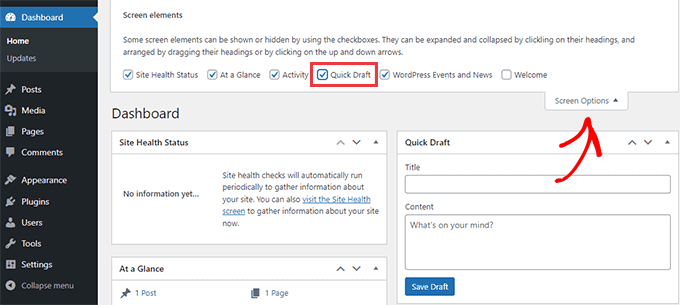
Method 2: Find Missing Drafts in the WordPress Pages and Posts Menus
Another easy way to find your saved drafts on your WordPress blog or site is to head over to Posts » All Posts for your draft posts, or Pages » All Pages for draft pages.
Once you’ve done that, you should see a ‘Drafts’ tab.
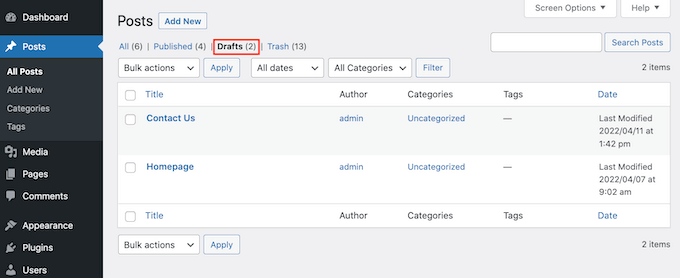
After clicking on the Drafts tab, you’ll see your saved draft posts.
You can now see options to edit, trash, or preview any of these posts by hovering your mouse over the draft.

Method 3: Use the Direct Link to View all Your WordPress Post Drafts
Another option is to jump straight to the ‘Drafts’ screen using a direct link.
To start, make sure you are logged in to your WordPress dashboard. For more information, please see our guide on how to find your WordPress login URL.
Once you’ve done that, you’ll need to add some text to the end of your WordPress website’s URL. This text will be different depending on whether you want to see your drafted posts or pages.
To find all of your drafted posts, add the following to the end of your website’s URL:
/wp-admin/edit.php?post_status=draft&post_type=post
For example, if your website’s URL was ‘www.example.com’, then you would need to paste the following into your browser’s address bar:
www.example.com/wp-admin/edit.php?post_status=draft&post_type=post

Then just press the ‘Enter’ key on your keyboard. You will now be redirected to a screen showing all your drafted WordPress posts.
To see all of your drafted pages instead, add the following to the end of your website’s URL and press ‘Enter’:
/wp-admin/edit.php?post_status=draft&post_type=page
Once you’ve done that, WordPress will show a screen containing all of your drafted pages.
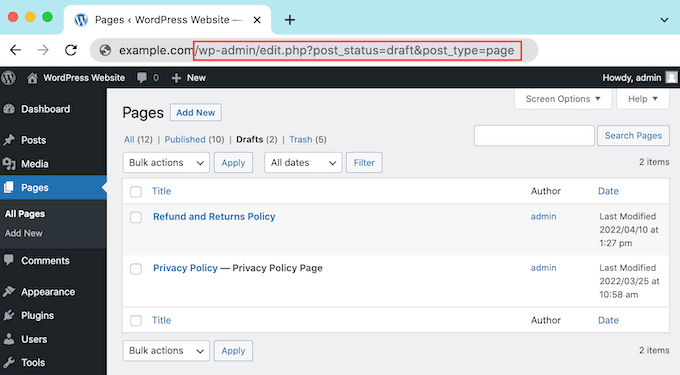
Method 4: Check Your WordPress Trash for Missing Drafts
Have you checked the ‘Drafts’ tab but still can’t find your drafted page or post?
If a draft is missing, there’s a chance it may have been deleted by accident. If you’ve added other WordPress users or authors to your site, then it’s possible someone else may have deleted your draft.
Or, you may have set up an automation to empty your WordPress trash regularly.
Luckily, WordPress makes it easy to restore deleted posts and pages.
Just like your computer, WordPress moves deleted items into a ‘Trash’ folder. These pages and posts will no longer show up in your ‘Drafts’ tab, but they’re not deleted permanently right away.
By default, WordPress will keep items in the trash folder for 30 days. If you want to change how often your trash is emptied, then please see our guide on how to limit or disable the trash being automatically emptied in WordPress.
To look inside your trash folder, either go to Pages » All Pages, or Posts » All Posts. Once you’ve done that, simply click on the ‘Trash’ tab.
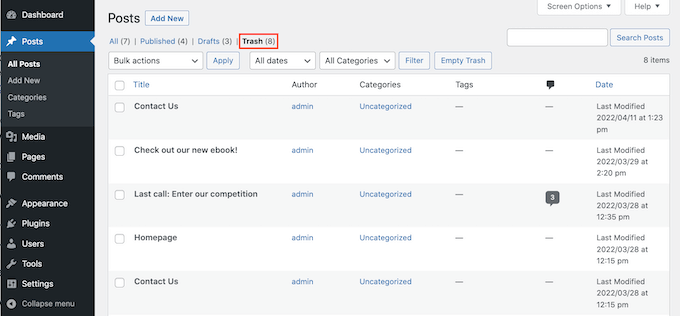
Here you’ll find all your deleted posts or pages. If you see your missing draft, then hover your mouse over it.
After that, just click on the ‘Restore’ link.

Now, you can find this drafted page or post in your ‘Drafts’ tab following the same process described above.
Method 5: Check Your WordPress Database to Recover Lost Drafts (Advanced)
Can’t find the missing draft in your WordPress ‘Trash’ folder?
Another option is to check your WordPress database. You can’t recover the deleted draft using this method, but you can get its content. Once you do, then you can copy and paste it into a new draft in your WordPress admin area.
This method is more advanced, so it isn’t recommended for absolute beginners.
If you decide to go ahead with this method, then it’s a good idea to create a backup. Backups allow you to quickly restore your WordPress site in case something bad was to happen.
Plus, you can easily create backups with a WordPress plugin. You can see our expert pick of the best WordPress backup plugins to get started.
To reach your WordPress database, you’ll first need to log in to your web hosting account. This is usually supplied by your WordPress hosting provider.
For example, if you are a Bluehost customer, then you just need to log in to your Bluehost dashboard.
Once you’ve logged in, navigate to the ‘Websites’ tab. Then, select the ‘Settings’ button for the website you want to find drafts in.
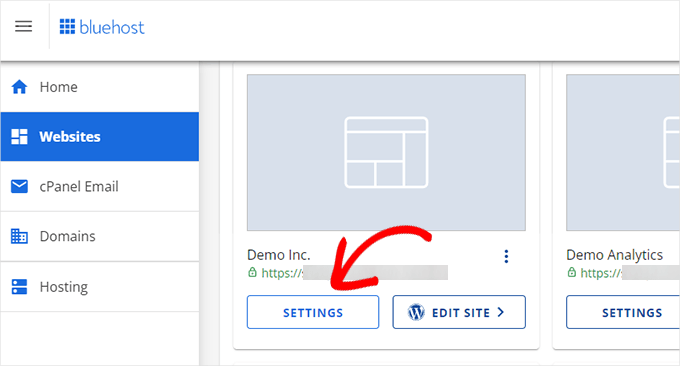
Next, just scroll down to reach the ‘Quick Links’ section.
After that, click ‘phpMyAdmin.’
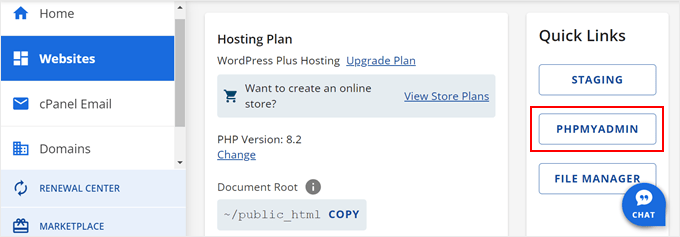
You can then click on the ‘Databases’ tab.
In the left-hand menu, find the name of your WordPress database.
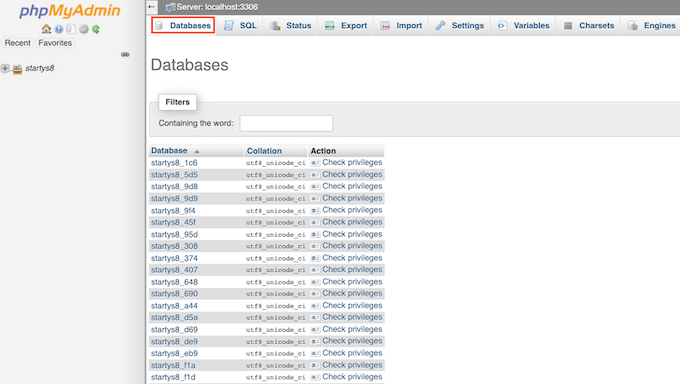
Note: If you are not sure what your database name is, then you can find this information in your wp-config.php file.
In the left-hand menu, find an option that has ‘posts’ in its name.
Then, click to select this option. You will now see all of your WordPress posts and pages.
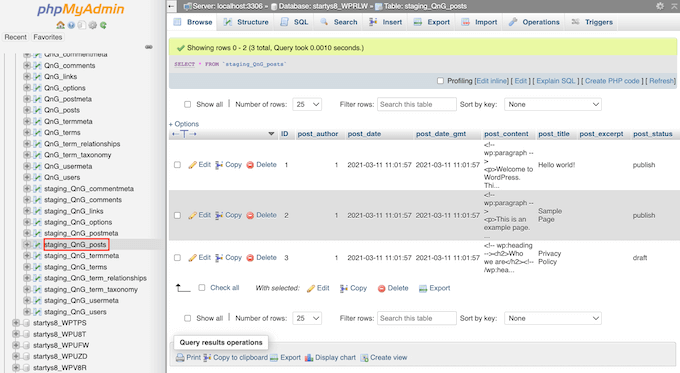
Next, find the draft that you want to restore.
You can then go ahead and click on its ‘Edit’ button.
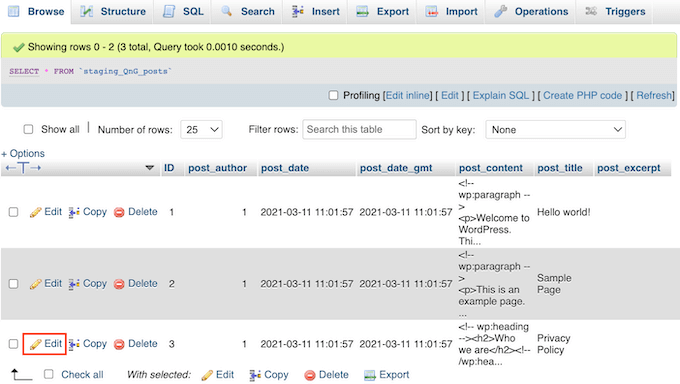
Once you’ve done that, phpMyAdmin will show this draft in HTML format.
To restore this draft, simply copy everything in the ‘post_content’ section.
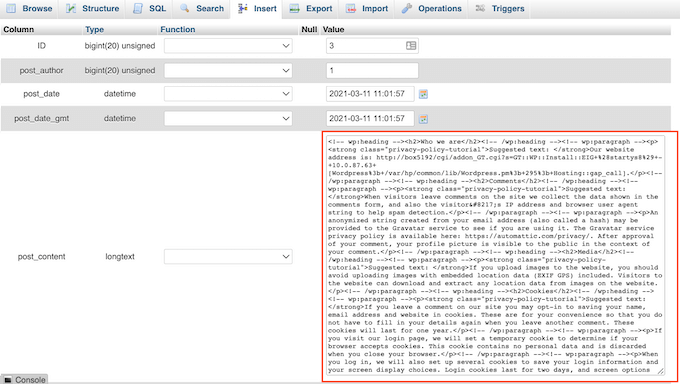
Now it’s time to switch back to your WordPress admin screen. Here, you can create a new post or page.
In the upper-right corner, click on the icon that shows a line of dots.
After that, click on ‘Code editor’.
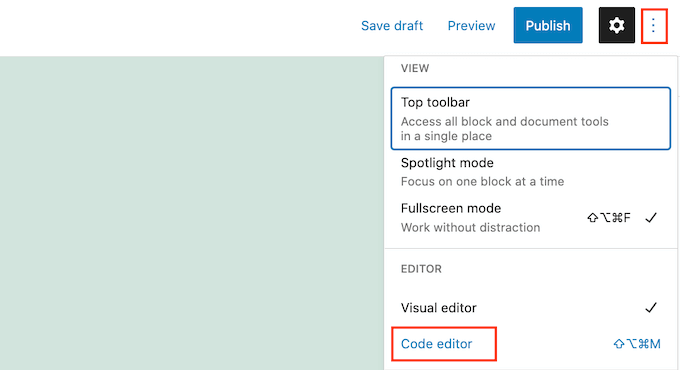
This will open this page or post in the WordPress code editor.
Now simply paste the HTML code you copied in the previous step. Once you’ve done that, click on ‘Exit code editor’.

You will now see all of the content you copied from your WordPress database. To check how this draft will look to the people who visit your website, click on the ‘Preview’ button.
You can now work on this draft in the WordPress editor.
Beginner-Friendly Guides to Manage Your WordPress Site
Now that you’ve mastered finding your drafts, let’s explore other essential WordPress management skills. These guides will help you streamline your site management:
- How to Bulk Delete WordPress Posts – Learn efficient ways to remove multiple posts at once, saving you time and effort.
- How to Add or Change Your Full Name in WordPress – Discover how to update your profile information correctly in WordPress.
- How to Change Date and Time Format in WordPress – Customize your site’s date and time display to match your preferences or locale.
- What, Why, and How-To’s of Trackbacks and Pingbacks in WordPress – Understand these communication tools between WordPress sites and how to use them effectively.
- How to Upload PDF Files to Your WordPress Site – Master the process of adding PDF documents to your posts and pages for easy sharing.
- How to Test Your WordPress Theme Against Latest Standards – Ensure your theme is up-to-date and compatible with the latest WordPress version and web standards.
We hope this article helped you learn how to find your saved drafts in WordPress. You may also want to see our guide on how to find post, category, tag, comment, or user ID in WordPress and our expert picks for the best Zapier alternatives to automate your website.
If you liked this article, then please subscribe to our YouTube Channel for WordPress video tutorials. You can also find us on Twitter and Facebook.





Dennis Muthomi
I manage multiple WordPress sites and I’ve encountered the frustration of “lost” drafts more times than I’d like to admit. The step-by-step instructions for each method are incredibly helpful.
I particularly appreciate the inclusion of Method 5, which dive into database recovery. While it’s advanced, it’s a valuable skill for WordPress users to learn.
Thank you for this valuable resource. It’s articles like these that make WPBeginner an indispensable tool for WordPress users of all levels.